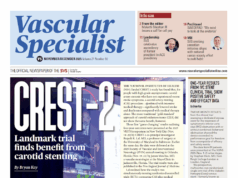
Dual antiplatelet therapy (DAPT) has demonstrated improved clinical outcomes, including reduced in-hospital stroke and mortality risks, compared to other medication regimens in carotid disease patients who undergo stent placement via a transcarotid artery revascularization (TCAR) procedure.
This is the key concluding message put forward by Hanaa Dakour-Aridi, MD, an integrated vascular surgery resident at Indiana University School of Medicine in Indianapolis, S. Keisin Wang, MD, an assistant professor of vascular and endovascular surgery at McGovern Medical School at UTHealth in Houston, and colleagues in a recent Journal of Vascular Surgery (JVS) publication.
The authors queried all patients who underwent TCAR within the Vascular Quality Initiative (VQI) from September 2016 to June 2022 to determine the association between antiplatelet choices and outcomes. They did this against the backdrop of DAPT being the preferred medication regimen in post-TCAR patients, “despite a dearth of quality data,” in an effort to define the risks carried by different antiplatelet approaches.
“Patients maintained on DAPT were compared with those receiving alternative regimens consisting of single antiplatelet [therapy], anticoagulation, or a combination of the two,” Dakour-Aridi, Wang and colleagues note. “A 1:1 propensity-score match was performed with respect to baseline comorbidities, functional status, anatomic/physiologic risk, medications and intraoperative characteristics. In-hospital and one-year outcomes were compared between the groups.”
The authors report that a total of 29,802 procedures were included in their study population, with 82.7% receiving DAPT and 17.3% receiving an alternative antiplatelet regimen. Propensity-score matching generated 4,876 unique pairs across which they performed their analysis.
Compared with patients on DAPT, in-hospital ipsilateral stroke rates were “significantly higher” among those receiving other types of antiplatelet therapy (1.1% vs 1.7%, respectively). And, while there was no statistically significant difference between the two groups regarding mortality—0.5% with DAPT and 0.6% without—a composite of stroke/death was more likely in patients receiving an alternative regimen (2.4%) rather than DAPT.

Furthermore, Dakour-Aridi, Wang and colleagues found that immediate stent thrombosis was more common in the ‘alternative’ group of patients, and a non-significant trend towards increased rates of returning to the operating room was observed as well.
“Conversely, the incidence of perioperative myocardial infarction was lower in the alternative regimen group [than with DAPT],” the authors posit, highlighting rates of 0.4% and 0.7%, respectively. “At one year after the procedure, we observed an increased risk of mortality but not stroke in patients treated with an alternative medication regimen.”
Dakour-Aridi, Wang and colleagues ultimately convey that their propensity score-matched analysis found an increased risk of both in-hospital stroke and one-year mortality in TCAR recipients who were treated with an alternative approach to DAPT. And, although patients on triple therapy experienced the same rate of major adverse cardiovascular events (MACE) as DAPT, bleeding events were not available in the VQI, the authors also note.
“Further studies are needed to elucidate the drivers of DAPT failure in patients undergoing TCAR to improve outcomes for carotid stenting patients,” they conclude.












